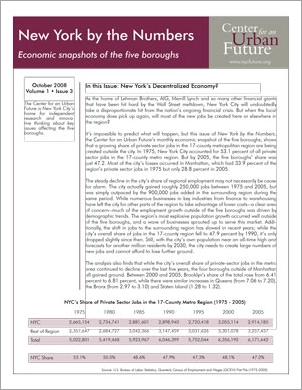Click here to read the full report (PDF).
As the home of Lehman Brothers, AIG, Merrill Lynch and so many other financial giants that have been hit hard by the Wall Street meltdown, New York City will undoubtedly take a disproportionate hit from the nation's ongoing financial crisis. But when the local economy does pick up again, will most of the new jobs be created here or elsewhere in the region?
It's impossible to predict what will happen, but this issue of New York by the Numbers, the Center for an Urban Future's monthly economic snapshot of the five boroughs, shows that a growing share of private sector jobs in the 17-county metropolitan region are being
created outside the city. In 1975, New York City accounted for 53.1 percent of all private sector jobs in the 17-county metro region. But by 2005, the five boroughs’ share was just 47.2. Most of the city’s losses occurred in Manhattan, which had 33.9 percent of the region's private sector jobs in 1975 but only 28.8 percent in 2005.
The steady decline in the city’s share of regional employment may not necessarily be cause for alarm. The city actually gained roughly 250,000 jobs between 1975 and 2005, but was simply outpaced by the 900,000 jobs added in the surrounding region during the same period. While numerous businesses in key industries from finance to warehousing have left the city for other parts of the region to take advantage of lower costs—a clear area of concern—much of the employment growth outside of the five boroughs was driven by demographic trends. The region’s most explosive population growth occurred well outside of the five boroughs, and a wave of businesses sprouted up to serve this market. Additionally, the shift in jobs to the surrounding region has slowed in recent years; while the city’s overall share of jobs in the 17-county region fell to 47.9 percent by 1990, it’s only dropped slightly since then. Still, with the city’s own population near an all-time high and forecasts for another million residents by 2030, the city needs to create large numbers of new jobs and cannot afford to lose further ground.
The analysis also finds that while the city’s overall share of private-sector jobs in the metro area continued to decline over the last five years, the four boroughs outside of Manhattan all gained ground. Between 2000 and 2005, Brooklyn’s share of the total rose from 6.41 percent to 6.81 percent, while there were similar increases in Queens (from 7.06 to 7.20), the Bronx (from 2.97 to 3.10) and Staten Island (1.28 to 1.32).


